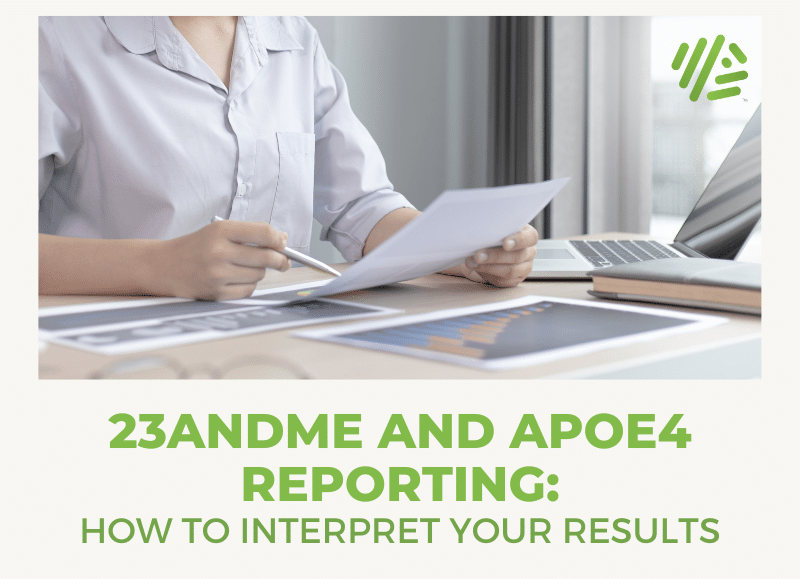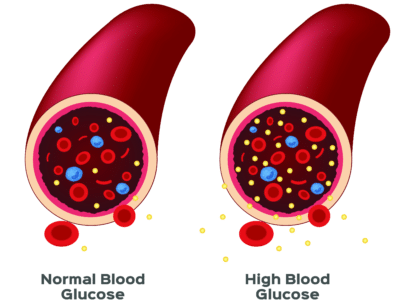Why 23andme APOE Reporting Is Incomplete (And What to Do Instead)
Article at a Glance
- 23andme only reports on one of the relevant SNPs for determining ApoE4 status. This leaves open the possibility that someone could be listed as a 3/4 in 23andme and carry two copies of ApoE4.
- In order to get the full picture of your APOE status, order a genetic test that reports on rs429358 and rs7412.
- APOE 3/4 = rs429358 C/T and rs7412 C/C
- APOE4/4 = rs429358 C/C and rs7412 C/C
Genes Mentioned

Contents
We’re writing this blog to address a relatively common question we get about a protein known as apolipoprotein E (ApoE) and how people can get conflicting results about some key variants in the APOE gene when comparing their 23andMe health report, with that from other sites.
What is ApoE?
ApoE is a protein that is involved in the metabolism of fats, and when combined with fat, forms a very-low-density lipoprotein (VLDL). For this reason there is a lot of interest around APOE and cardiovascular health. But APOE is perhaps more famous because of a strong correlation between certain polymorphisms and an increased risk of developing Alzheimer’s disease (AD) in older age. For more on ApoE4, consider checking out our case study podcast on how ultramarathon runner Gerald Holbrook changed his diet to account for his ApoE status.
ApoE4 does NOT guarantee Alzheimer’s disease
Before we go further I really want to focus on the “increased risk” highlighted in bold. Carrying the SNPs with this associated risk DOES NOT mean you will develop AD, it simply means that your risk is increased. There are many other risk factors out there (smoking, obesity etc), but ApoE status gets a lot of interest as it’s easy to test for and often seems scarier as it’s not a factor that can be easily mitigated (for example by giving up smoking).
These ApoE variants are thought to increase the risk of developing AD by increasing the aggregation of Amyloid β protein, a hallmark of the disease, although this hasn’t been confirmed and other potential mechanisms exist. 1
What are the ApoE variants and what do they mean?
Here’s where it gets somewhat confusing. There are three common alleles for the APOE gene. Apo-ε2, ε3 and ε4 (often called E2 etc…). There are also some less common versions such as ε1 and even an ε5 allele.
You may read that these forms just don’t exist, that is incorrect they are just rare. For now let’s focus on ε2 to ε4. As you know, we carry two copies of almost every gene in the body. That means that you can have one copy of ε2 and one of ε4, or two of ε4 and so on.
Knowing which two copies you have is important as from this you can infer your AD risk. I’ve summarized the various risks in the table below which are adapted from this paper. 2
| APOE Allele 1 | APOE Allele 2 | AD Risk |
|---|---|---|
| ε2 | ε2 | 0.8 |
| ε2 | ε3 | 0.8 |
| ε2 | ε4 | 1.4 |
| ε3 | ε3 | Neutral 1 |
| ε3 | ε4 | 1.4 |
| ε4 | ε4 | 3.9 |
So from the above you can see that carrying two copies of ε4 significantly increases your risk of developing AD. There are several studies that have looked at this and so you may often see different numbers, but the pattern is the same. Again, increased risk is NOT guaranteed Alzheimer’s disease. If anything, learning you carry an ApoE4 variant is a signal that watching what you eat, blood pressure, exercise, and what your blood lipid markers look like is all that much more necessary.
So how do I determine what ApoE variants I have?
The best and most accurate way to determine this is to sequence your APOE gene which will give you the most accurate readout.
But this isn’t feasible for many people, and so the next best way is to use your raw data from a consumer genotyping service such as 23andMe or ancestry.com. And this is where it gets really interesting. If we focus on the most common three variants again there are two SNPs we’re interested in, rs429358 and rs7412.
I’ve summarised these in the table below.
| rs429358 | Allele |
|---|---|
| T | ε2 |
| T | ε3 |
| C | ε4 |
Importantly this is the only SNP that 23andMe use to determine your ApoE status in their health report for the V3 and V4 chips. The latest 23andme chip version carries both relevant SNPs for calculating APOE status.
Let’s expand that table and see if there may be a better approach.
| rs429358 | rs7412 | Allele |
|---|---|---|
| C | T | ε1 |
| T | T | ε2 |
| T | C | ε3 |
| C | C | ε4 |
The bottom line
In sum, and due to FDA regulation, 23andme only reports on one of the relevant SNPs for determining ApoE4 status. This leaves open the possibility that someone could be listed as a 3/4 in 23andme and actually carry two copies of ApoE4.




Hi Dr. Gardner! First and foremost, THANK-YOU for writing this blog. Like so many others, when I checked in on 23andme and discovered that I had one e4 variant, I was decidely worried. The charts you included are tremendously helpful, but I still have some questions. As per my result, my rs429358 indicated a C variant (e4) whilst my other parent have given me a T variant. The question, as you aptly put it, is whether that T variant is e3 or e2. This brings me to your second, expanded chart. I’m afraid this is where I get confused. As 23andme doesn’t check for the rs7412 SNP, does this mean the 23andme results only give one piece of the puzzle? Also, I gather from frantically googling things (hey, I’m only human) that whether i”m e2/e4 or e3/e4 the risk remains about double? (At 75, they cite the avg risk at 3% for females and with the e4 variant it is 5-7%) Based on your chart, could it mean that if they tested rs7412 SNP for me, my risk factors could either decrease or increase? You reference an e1 form of ApoE and I’m afraid I don’t know what that means? Thanks for your help. I’m trying to not get too worried, but the looming prospect of mental decline is daunting for anyone. 🙁
Hi Melanie, weighing in for Dr. Aaron who is up to his eyeballs in child care duties 🙂 Yes, the takeaway here is that 23andme reports on, as you say, only “one piece to the puzzle” as it pertains to ApoE4. Do keep in mind that some increased risk does not mean you will develop Alzheimer’s.